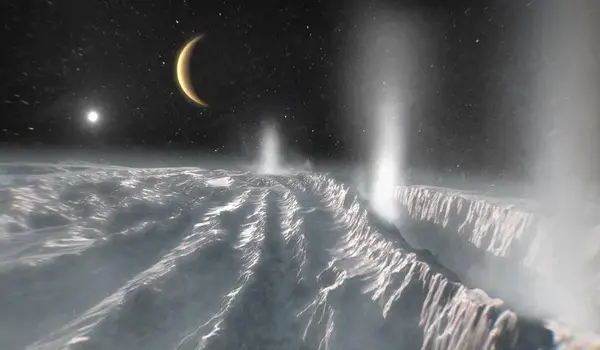A NASA study suggests that 17 exoplanets (worlds outside our solar system) may have oceans of liquid water, a crucial element for life, beneath ice shells. Water from these oceans could periodically erupt as geysers through the ice crust. This is the first time that scientists have calculated the quantity of geyser activity on these exoplanets. They discovered two exoplanets that were close enough for telescopes to see evidence of these eruptions.
Exoplanets in a star’s “habitable zone,” a distance where temperatures allow liquid water to persist on their surfaces, are often the focus of the hunt for life elsewhere in the Universe. However, if an exoplanet is too distant and cold, it may still contain an ocean beneath an ice crust provided it has adequate internal heating. In our solar system, Europa, a Jupiter moon, and Enceladus, a Saturn moon, both have subsurface oceans that are heated by tides caused by the gravitational attraction of the host planet and nearby moons.
These underground oceans may be able to support life if they have other requirements, such as an energy supply and elements and chemicals required in biological molecules. On Earth, vast ecosystems exist in total darkness near hydrothermal vents, which give energy and nutrients.
Our analyses predict that these 17 worlds may have ice-covered surfaces but receive enough internal heating from the decay of radioactive elements and tidal forces from their host stars to maintain internal oceans.
Dr. Lynnae Quick
“Our analyses predict that these 17 worlds may have ice-covered surfaces but receive enough internal heating from the decay of radioactive elements and tidal forces from their host stars to maintain internal oceans,” said Dr. Lynnae Quick of NASA’s Goddard Space Flight Center in Greenbelt, Maryland. “Thanks to the amount of internal heating they experience, all planets in our study could also exhibit cryovolcanic eruptions in the form of geyser-like plumes.” Quick is lead author of a paper on the research published on October 4 in the Astrophysical Journal.
The researchers looked at 17 verified exoplanets that are roughly Earth-sized but less dense, implying that they could have significant amounts of ice and water instead of heavier rock. Although the specific compositions of the planets are unknown, preliminary estimates of their surface temperatures from prior studies all show that they are significantly colder than Earth, implying that their surfaces could be covered in ice.
The study improved estimates of each exoplanet’s surface temperature by recalculating them using Europa’s and Enceladus’ known surface brightness and other features as models. The scientists also calculated the total internal heating in these exoplanets by calculating the heat created by tides and adding it to the heat expected from radioactive activity based on the shape of each exoplanet’s orbit.

Surface temperature and total heating estimates gave the ice layer thickness for each exoplanet since the oceans cool and freeze at the surface while being heated from the interior. Finally, they compared these figures to Europa’s and used estimated levels of geyser activity on Europa as a conservative baseline to estimate geyser activity on the exoplanets.
They expect that surface temperatures will be up to 60 degrees Fahrenheit (16 degrees Celsius) cooler than previously estimated. Proxima Centauri b’s estimated ice shell thickness ranged from roughly 190 feet (58 meters) for Proxima Centauri b and one mile (1.6 kilometers) for LHS 1140 b to 24 miles (38.6 kilometers) for MOA 2007 BLG 192Lb, compared to Europa’s estimated average of 18 miles (nearly 29 kilometers). Estimated geyser activity ranged from 17.6 pounds per second (about 8 kilograms/second) for Kepler 441b to 639,640 pounds per second (290,000 kilograms/second) for LHS 1140b and 13.2 million pounds per second (six million kilograms/second) for Proxima Centauri b, compared to Europa, which was 4,400 pounds per second (2,000 kilograms/second).
“Since our models predict that oceans could be found relatively close to the surfaces of Proxima Centauri b and LHS 1140 b, and their rate of geyser activity could exceed Europa’s by hundreds to thousands of times, telescopes are most likely to detect geological activity on these planets,” said Quick, who is presenting this research December 12at the American Geophysical Union meeting in San Francisco, California.
When the exoplanet passes in front of its star, this activity may be observed. Water vapor from the geysers could reduce or block some colors of starlight. “Sporadic detections of water vapor in which the amount of water vapor detected varies with time, would suggest the presence of cryovolcanic eruptions,” he stated. Other elements and compounds in the water could show whether or not it can support life. Because elements and compounds absorb light at specific “signature” hues, scientists may use starlight analysis to establish the geyser’s composition and assess the exoplanet’s habitability potential.
Geyser activity could be discovered by large observatories capable of measuring light that the exoplanet reflects while around its star for planets like Proxima Centauri b that do not cross their stars from our perspective. Geysers would discharge frozen particles at the exoplanet’s surface, making it appear extraordinarily brilliant and reflective.
















